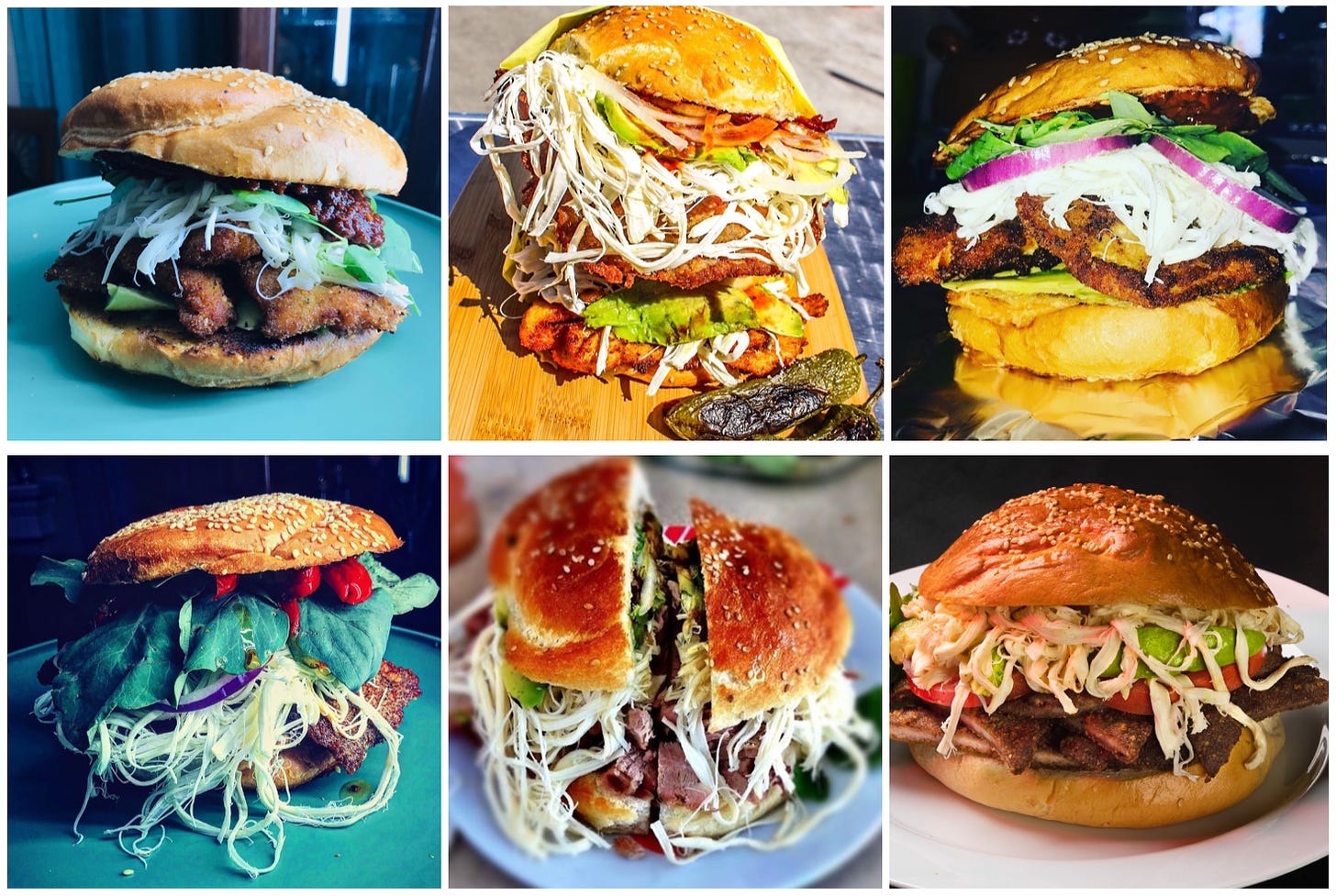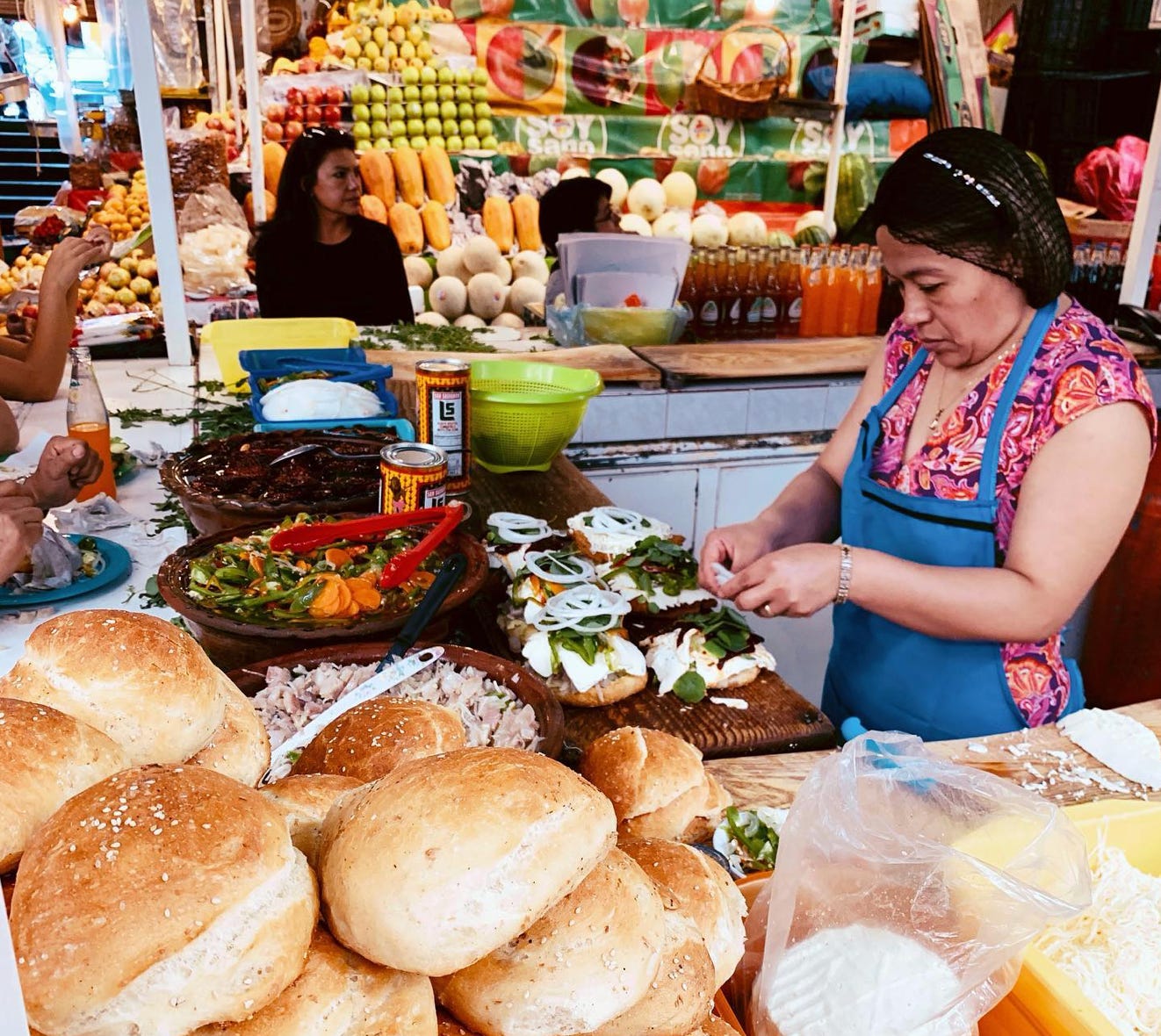Notable Sandwiches #28: The Cemita
Sometimes a sandwich can wrench you away from the world’s agonies
Welcome to the latest installment of Notable Sandwiches, the feature where I, alongide my editor David Swanson, stumble through the demented and mysterious document that is Wikipedia’s List of Notable Sandwiches. This week: a Mexican masterpiece, the cemita.

The cemita is a sandwich that is not messing around.
It’s not a frou-frou hors d'oeuvre, not a crusts-cut-off, appetite-teasing sort of an affair, and has no desire whatsoever to amuse your bouche. A cemita arrives in a great warm lump, more than ample enough to fill both hands, filled with spicy peppers and avocado and meat and cheese, all bound in a sesame-seed-festooned roll. It says in a firm and insistent way: Here is Food, Get To It. And it would be foolish to disobey the imperative, because in addition to being filling, the cemita is delicious.
The cemita—or cemita poblana—is a mainstay in the Mexican city of Puebla, a great font of culinary genius where mole sauce was born. A regional variation of Mexico’s national sandwich, the torta, the cemita distinguishes itself by its crispy sesame-seed roll, liberal usage of papalo (porophyllum ruderale, a broad-leafed herb whose chopped leaves taste something like arugula, something like cilantro, and something like bitter sage), and tangled shreds of Oaxaca cheese cohering a mass of avocado and hot pepper.
The Sword and the Sandwich is a newsletter about deadly serious extremism and equally serious sandwiches. Please consider supporting this work with a paid subscription:
As in many Mexican dishes, avocado features as a kind of unctuous fatty lubricant, which I realize is quite a disgusting phrase for so nice an effect, but Kenji Lopez-Alt did once call an avocado “nature’s mayonnaise,” and I’m sure he’s not wrong. And anyway, slicing into the buttery green flesh is much less fiddly than time spent with a whisk, egg yolks, and thin drizzles of oil, and both healthier and more satisfying than breaking into a jar of Hellman’s. The avocado adds… not a je ne sais quoi, because I have a pretty good idea. It adds a gentle fullness to the taste, taking the sting out of the crowd of chipotles, alleviating any dryness in the bun and the meat, letting the whole enormous bread-robed article skate across the tongue with surprising grace.
The avocado is native to Mexico and has been cultivated there since time immemorial—which is another way to say “since the people who consider themselves arbiters of history started writing things down.” And while a lot of people who didn’t consider themselves arbiters of history—merely people who lived and built and died and grew in Central and South America—have cultivated the avocado for a very long time, the now-ubiquitous habitué of the produce aisle wasn’t mass-cultivated until the twentieth century. Grafted trees allowed for whole orchards, and, hanging among sharp crescent-shaped leaves, the avocado earns its other name—the alligator pear, a teardrop dressed like a reptile.
In most languages an avocado is more or less an avocado, just transliterated out of the Latin alphabet or given a definite article. But in Spanish it’s an aguacate—a colonial corruption of the Aztec word ahuakatl, which means avocado and also means testicle. Probably for the shape. Possibly because it’s life-giving? Or because it’s temperamental in the cold? In Peru they’re called “palta,” from the Quechua word “pallta,” and are a synonym for embarrassment (que palta!), because things can go pear-shaped no matter where you live.
I adore avocados—as mentioned in this column before, I have trouble eating solid food sometimes when I’m really anxious, and anything so forgiving to a stress-clenched throat would be a serious candidate for adoration even if it didn’t taste like delicious grassy buttery greenness. I like how temperamental they are—rock-hard until the right time, spoiled thereafter, with those disheartening strata of grayness that can sometimes be carved out and sometimes not. You have to pay attention to eat an avocado properly. And when you do, you can scoop it from its leathery skin with a spoon, a few flecks of pepper, a skittering of salt and a pop of lemon its bare adornments. It is perfect alone, perfect wedged into a cemita, the complete article. And you can fit it in the palm of your hand.
Avocado orchards thrive in the fertile, volcanic soil of Michoacan, the hillsides of California, and, of course, in Puebla, where they complement a sandwich so filling it crowds out all other mealtime considerations. You would be a fool to order a side dish with a cemita—unless you’re Joey Chestnut, or had scaled a mountain without any food in your pack. Not unlike the avocado, it is a perfect whole, a warm round solitary article that needs no elaboration. It stings and tantalizes the tongue and even the bread is good bread, springy and crisp.
For once, I’m not writing about the legacy of imperialism, or the labor exploitation in the fields, or the blood spilled for avocados over the centuries. Not because they don’t exist or are not valuable and important stories, and ones even that I would like to tell. But just because sometimes a warm breaded whole can wrench you into the present, away from the world’s agonies, unsplitting the consciousness, funneling it until the whole of your mind is concentrated on what your body is doing, which is falling in love with its own fullness. That is the gift of the table, the reason I keep coming back to writing about these sandwiches: the way at the moment of consumption all the words I use as a great sesquipedalian barrier between myself and the world melt away, and all that’s left is a now that will last as long as the taste and scent of the cemita. And because it is a cemita, and it is generous and it is giving, it lasts just long enough.









You are such a talented writer. Your work -- fluffy or somber -- is always a joy to read. The last time I had this much fun reading a new author was back in the 90's when I discovered Anthony Lane in the New Yorker. Thank you! Also: a collection of these sandwich pieces would make a great cook/food book (esp if it included recipes)!
This was such a damn good description of the sandwich and also avocado. nom. nom. nom.